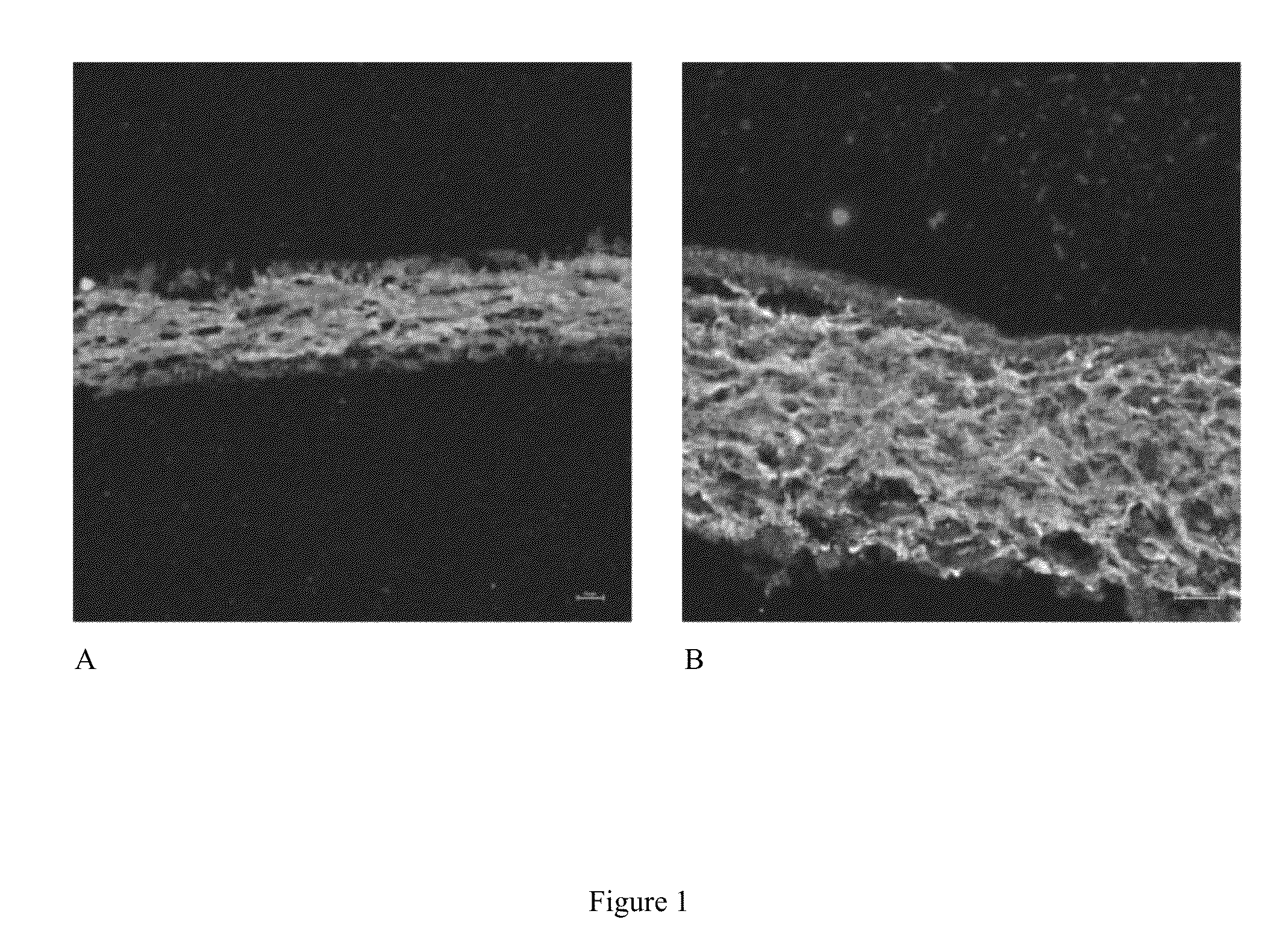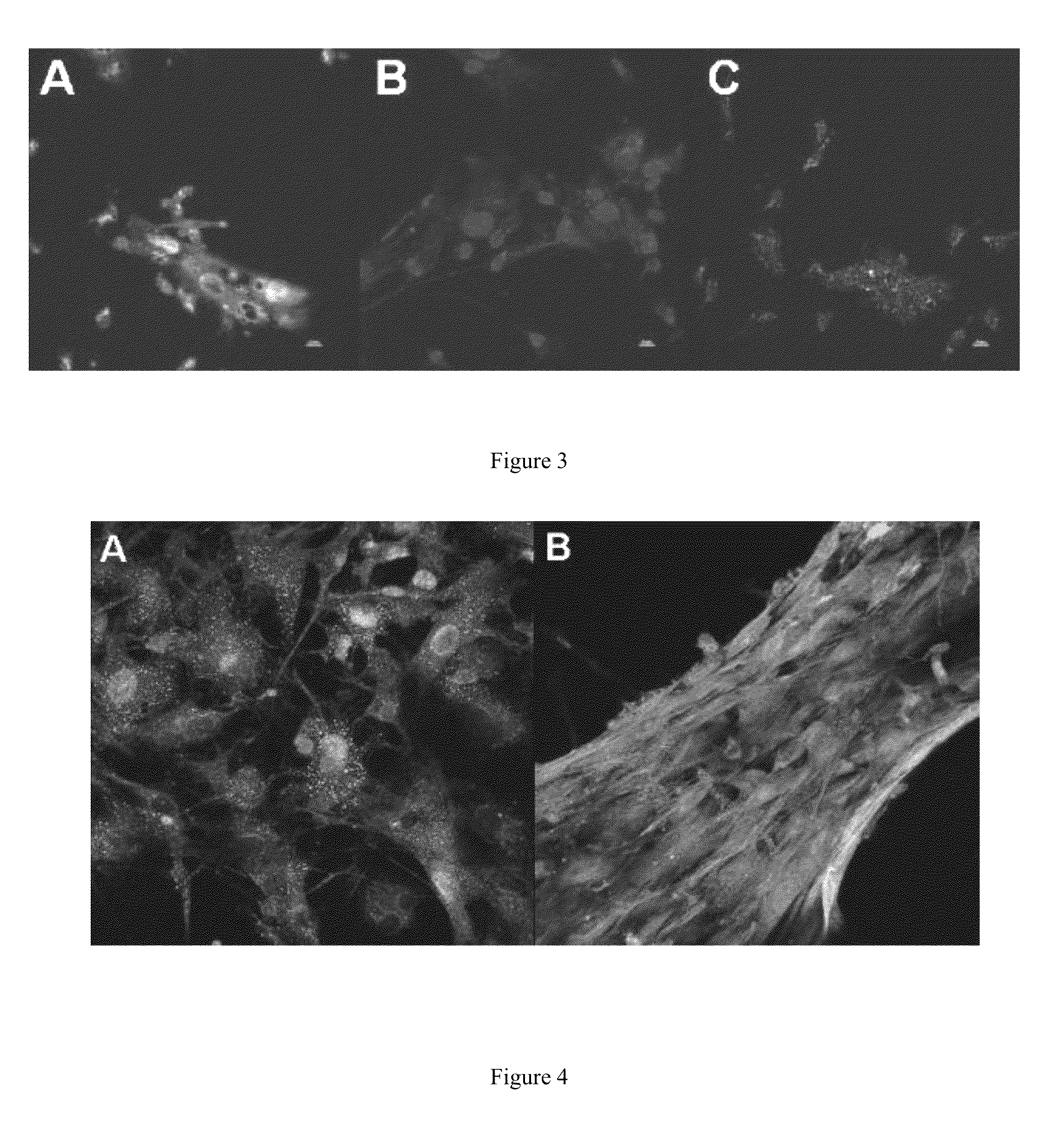3-dimensional cardiac fibroblast derived extracellular matrix
a fibroblast and extracellular matrix technology, applied in the field of 3-dimensional cardiac fibroblast derived extracellular matrix, can solve the problems of inability to demonstrate robust cardiac regeneration, lack of unique structural characteristics, and inability to engraft large-scale cells or functional cardiomyocyte regeneration in infarcted hearts, so as to facilitate the delivery of seeded cells and move flexibly.
- Summary
- Abstract
- Description
- Claims
- Application Information
AI Technical Summary
Benefits of technology
Problems solved by technology
Method used
Image
Examples
example 1
Production and Characterization of Cardiac Derived 3-Dimensional Extracellular Matrix
[0061]In this Example, we generated a 3D-ECM using cardiac fibroblasts that is measured by confocal microscopy to be between 30-150+ μm thick. Additionally, we devised multiple ways to remove the fibroblasts (decellularization), which allow for the study of the effect of cellular debris on stem cell attachment, proliferation and differentiation. Controlling (varying) the cell debris content is important because cellular debris is highly prevalent in the early phases of cardiac healing, and has largely been overlooked as a factor impacting therapeutic cell adhesion and differentiation. This new method of generating cardiac specific extracellular matrix will facilitate in vitro studies of stem cell interactions with a cardiac specific matrix.
[0062]An important first step in studying the CF 3D-ECM is carrying out detailed analyses of its composition and structure. This was done using bottom-up 2D-(stro...
example 2
Dynamic Adhesion of Mesenchymal Stem Cells to Cardiac Fibroblast 3-Dimensional Extracellular Matrix
[0134]Therapeutic cell adhesion and engraftment are essential to the success of cell-based therapy. Current techniques involving circulatory infusion (systemic or intracoronary) have been used in large scale clinical trials with mixed results, with extremely low reported retention rates for both systemic and intracoronary infusion. Intramyocardial injection (either epicardial or endocardial) tends to have greater cell retention rates than circulatory delivery modes and has the ability to deliver cells with limited extravasation potential, such as skeletal myoblasts. To date, studies quantifying cell retention in vivo have been difficult and expensive to perform.
[0135]To address this issue, we utilized an oscillatory dynamic adhesion assay developed by others to test the adhesion of BMSC to our CF 3D-ECM generated with AH or PAA and to cardiac fibroblasts (non-decellularized). We also d...
example 3
Cardiac Fibroblast Patches: Successful Adhesion of Epicardial Patch to Epicardium
[0173]Epicardial patches have emerged as a promising mode of therapeutic cell delivery for cardiac regeneration. One issue with using synthetic or decellularized tissues as patch materials is the inability of the patch to physically adhere to the surface epicardium, often requiring the use of glue or sutures to hold the patch to the heart. If the patch does not maintain firm contact with the surface of the heart, the ability of the cells to transfer is decreased significantly. We demonstrate in this Example that CF 3D-ECM adheres well to the surface of a heart, creating a unique cardiac based platform for therapeutic cell transfer. This work represents collaboration with the laboratory of Professor Brenda Ogle of the Stem cell and Regenerative Medicine Center at the University of Wisconsin-Madison. Nicholas Kouris of Professor Ogle's laboratory provided human mesenchymal stem cells and carried out the C...
PUM
| Property | Measurement | Unit |
|---|---|---|
| thickness | aaaaa | aaaaa |
| thickness | aaaaa | aaaaa |
| thickness | aaaaa | aaaaa |
Abstract
Description
Claims
Application Information
 Login to View More
Login to View More - R&D
- Intellectual Property
- Life Sciences
- Materials
- Tech Scout
- Unparalleled Data Quality
- Higher Quality Content
- 60% Fewer Hallucinations
Browse by: Latest US Patents, China's latest patents, Technical Efficacy Thesaurus, Application Domain, Technology Topic, Popular Technical Reports.
© 2025 PatSnap. All rights reserved.Legal|Privacy policy|Modern Slavery Act Transparency Statement|Sitemap|About US| Contact US: help@patsnap.com



